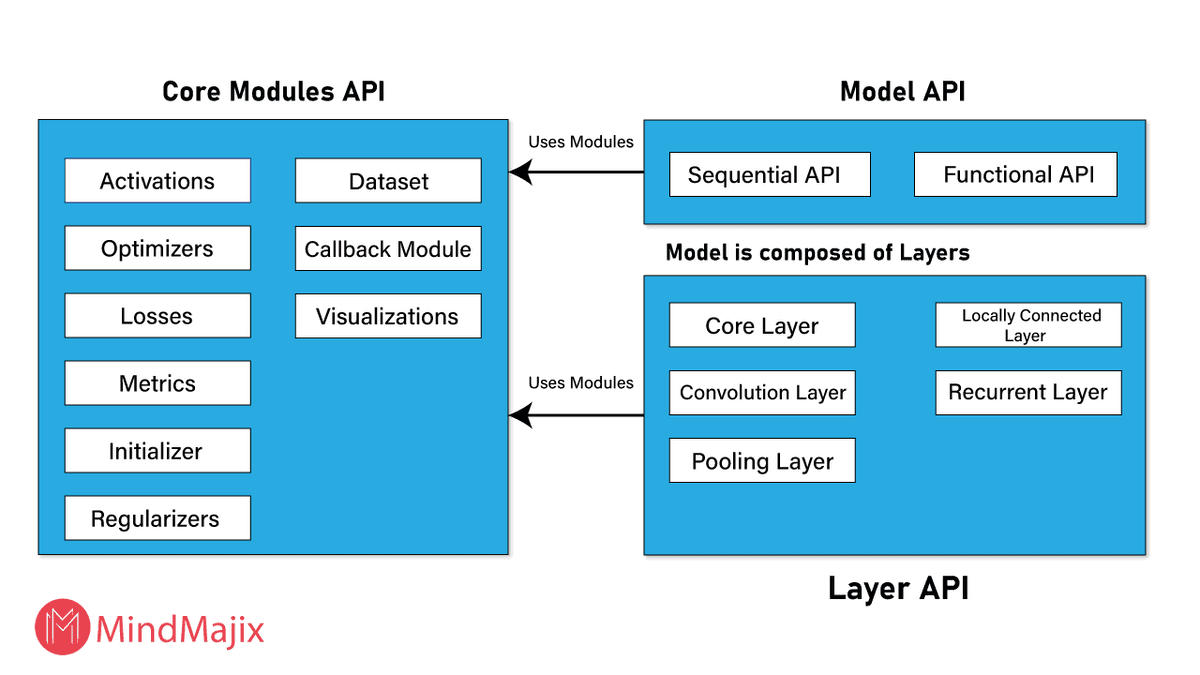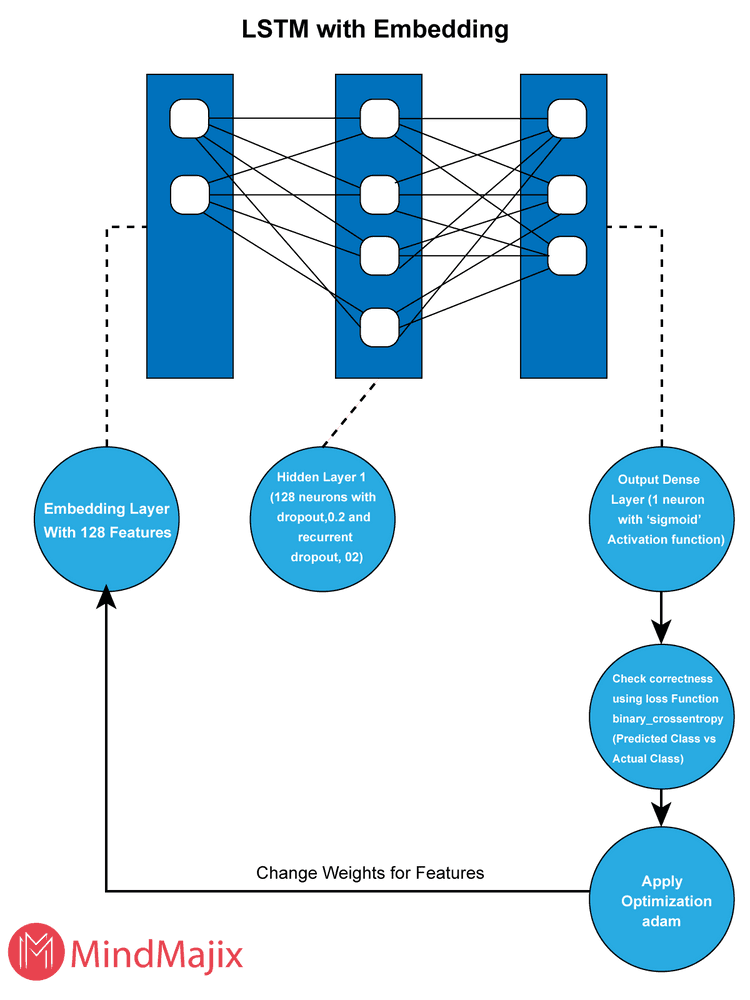- Home
- Blog
- Machine Learning
- Keras Tutorial

- TensorFlow Interview Questions
- How Oracle Embeds Machine-Learning Capabilities Into Oracle Database
- Machine Learning Applications
- Machine Learning Datasets
- Machine Learning Examples In Real World
- Machine Learning Interview Questions
- Machine Learning Techniques
- Machine Learning Tutorial
- Artificial Intelligence Vs Machine Learning
- Machine Learning with Python Tutorial
- Machine Learning with Spark
- Support Vector Machine Algorithm - Machine Learning
- Top 10 Machine Learning Algorithms
- Top 10 Machine Learning Books
- Top 10 Simple Machine Learning Projects For Beginners
- Skills Required for Machine Learning
- TensorFlow Object Detection
- TensorFlow Tutorial
- Installing TensorFlow
- TensorFlow 2.0 - A comprehensive platform that supports machine learning workflows
- What is Reinforcement Learning?
- Keras vs TensorFlow
- Machine Learning Projects and Use Cases
In this Keras tutorial, you will learn about the Keras framework or API. It is used to develop and define Deep Learning Models. It is implemented on the freeware machine libraries such as Theano, TensorFlow, etc. Keras Tutorial provides a simple method to Develop Deep Learning Models.
| Keras tutorial - Table of Content |
What is Keras?
Keras is a freeware deep learning framework of Python. It is developed by an artificial intelligence researcher whose name is “Francois Chollet”. It is a top-level neural network API developed in python. It supports both recurrent and convolutional networks and the amalgamation of both. Many Top companies, like Netflix, Google, Square, are presently using Keras tools. It is used to develop Deep Learning Models. It uses libraries of different programming languages like Python, C++, C, etc.
| Do you want to get certified and build your career in Keras? Then enroll in "Keras Online Training" this course will help you to achieve excellence in this domain. |
Keras Features
The features of Keras are as follows:
- Simple, extensible, and constant API.
- It supports backends and different platforms.
- Due to its Customizable framework, it can work on both GPU and CPU.
- Calculations are extremely scalable.
Advantages of Keras
The Advantages of Keras are as follows:
- It is tested easily.
- The neural networks of Keras are developed in Python, which is easy to understand.
- It endorses both recurrent and convolutional networks.
- It has great community support.
- As the models of deep learning are discrete components, they can be merged.
Keras is a framework of Deep Learning, so, let us study Deep Learning.
Deep Learning
Deep Learning is considered a subdomain of Machine Learning. The main job of deep learning is studying the input layer by layer. Some of the fundamentals of Deep Learning are as follows:
1. Artificial Neural Networks
The main method of deep learning is Artificial Neural networks. They are motivated by the human brain model. In the human brain, we will have interconnected neurons, in the same way in ANNs(Artificial Neural Networks), we will have interconnected nodes in the structure of hidden layers.
The nodes present in the inner layers will study the given input, and the input traverses through other hidden layers, and the output layer forecasts the output. The output layer may give the required output.
2. Multi-Layer Perceptron
It is the easiest form of ANNs. It contains one input layer, multiple hidden layers, and lastly an output layer. In Multi-layer Perceptron, one hidden layer will process some part of the input, and it will transmit that to the other hidden layer. Each hidden layer contains single or multiple neurons. The final hidden layer transmits the data to the output layer. The output layer gives the required output.
3. Convolution Neural Network
It is a well-known Artificial Neural network. It is hugely used for the purpose of video and image recognition. It is founded on a mathematical concept called “convolution”. It is identical to the Multilayer Perceptron. The main layers of Convolution Neural Network are as follows:
- Convolution Layer: It is a basic element and carries out arithmetic operations according to the convolution function.
- Pooling Layer: It is organized beside the convolution layer. It is used to reduce the scale of the input by eliminating redundant information.
- Fully Connected Layer: It is organized beside the pooling and convolution layer and categorizes data into different categories.
4. Recurrent Neural Network
It is used to detect the defects present in the other ANN Models. The main job of RNN is to save past data and decisions. This method is mainly used in image categorization. The RNN bidirectional is useful to anticipate the future according to the past.
Modules in Keras
The Existing Models of Keras are as follows:
- Constraints: This module is used to set various functions to limit the layer. Some constraint Functions are: 1) NonVeg 2) UnitNorm 3) MaxNorm.
- Callback: It gives a callback function list. It is used at the time of the training process to print the intermediate data, according to the given condition.
- Utilities: In deep learning, it is helpful in providing many utility functions.
- Text Processing: It gives functions for converting text into Numpy arrays, and this is useful for machine learning.
- Image Processing: It works the same as how Text Processing. Text Processing Function is used in the Machine Learning’s Preparation Phase.
- Sequence Processing: It is used to create time-based data from the input data.
- Initialiser: To assign the initial weight to the given data, we use the initializer model.
- Regularizer: Regularizer Module is helpful in the phase of optimization. The main job of a Regularizer is to fix the penalties on the layer.
Keras Architecture
The API of Keras is distributed into three primary categories:
- Model
- Layer
- Core Modules
In Keras, each ANN is indicated using Keras Models.

The above diagram represents the Keras Architecture.
Models
Keras Models are of two types, they are:
- Sequential Model
- It is a sequential arrangement of Keras Layers. The sequential model can depict all the existing neural networks.
- Functional API
- It helps to create complex models.
Layers
Each Keras layer present in the Keras model depicts the respective layer present in the real neural network model. The essential Keras Layers are as follows:
- Pooling layers
- Convolution Layers
- Core Layers
- Recurrent Layers.
Core Modules
Keras Provides some neural network functions; they are as follows:
Activations Module: It gives many activation functions like relu, softmax, etc.
- Optimizer Module: It gives optimizer functions like sgd, adm, etc.
- Regularizers: L 1 Regularizer and L 2 Regularizer functions are provided by Regularizers.
- Loss Module: It gives loss functions like Poisson, mean_absolute_error, etc.
Time Sequence Prediction through LSTM RNN
The sequence is a collection of values, and every value represents a specific instance of time. For example, if we are reading a sentence, we have to understand every word and the meaning of the word in a given perspective. In this scenario, values represent the words, the first value represents the first word, the second value represents the second word, and this order continues until the last word.

The features of the above model are as follows:
- The input layer of this model contains 128 features
- The first layer is dense and contains 128 units with recurrent dropout and normal dropout fixed to 0.2.
- The output layer is also dense and contains one unit and an activation function called ‘Sigmoid”.
- Adam is used as an optimizer.
- Accuracy is used as a metric.
- 32 is used as batch size.
- 15 is used as epochs.
Convolution Neural Network
The Convolution Neural Network is depicted as follows:

The important features of this model are as follows:
- Input Layer Contains (1,8,28) values.
- First Layer Contains “relu” activation functions and 32 filters.
- The second layer contains 64 filters and “relu” activation functions.
- The third Layer is Known as MaxPooling.
- The fifth layer is used to flatten the complete input data into one dimension.
- The sixth Layer is Known as “Dense” and contains “relu” activation function and 128 neurons.
- The seventh Layer is Known as “Dropout”, and its value is “0.5.”
- The last and Eight Layer Contains “softmax” neuron function and ten neurons.
- Accuracy is used for metrics.
- Adadelta() is used as an optimizer.
Model Evolution and Model Prediction
Model Evolution
At the time of development of the model, Evolution is a process to check the model is suitable for the problem and the respective data. To do the evolution process, Keras has a function. The three arguments of the function are as follows:
- Test data Label
- Verbose- false or true
- Test data
Model Prediction
The final step in the Keras Model Development is “ Model Prediction”. To make Model Prediction, Keras gives a method called “predict” and it predicts the trained model.
Keras VS TensorFlow
| Criteria | Keras | TensorFlow |
| Objective | It is used for developing conventional Layers | It is used for developing model layers or calculation tasks. |
| Tools | It will use API tools like TFDBG | It will use Tensorboard Visualization tools |
| Difficulty | If you have knowledge of Python, we can use Python easily | For using TensorFlow, we need to learn the syntax of some TensorFlow Functions |
| Type | It is a High-Level Wrapper | It is a Low-level API |
| Community | It has many active communities | It has many active communities |
Keras Applications
The Keras Applications is used for developing pre-trained models for the purpose of deep neural networks. Keras Models are used for fine-tuning, prediction, and feature extraction.
Pre-trained Models
Trained Models contains two modules: Model weights and Model architecture. Model weights are big files. Therefore you have to download it, and the feature should be
Extracted from the ImageNet database. The famous Pre-trained Models are as follows:
- InceptionV3
- VGG16
- ResNet
- MobileNet
Conclusion
Keras is considered as a framework used in deep learning to analyze the given input and develop the Deep Learning Models. It is built on libraries like Theano, Caffe, TensorFlow, Caffe, etc. It is more helpful in the image and video recognition process. As the requirement of machine learning is increasing, the demand for Keras framework and Deep Learning is also increasing. So, the professionals who are working with Machine learning must have knowledge of the Keras framework.
 On-Job Support Service
On-Job Support Service
Online Work Support for your on-job roles.

Our work-support plans provide precise options as per your project tasks. Whether you are a newbie or an experienced professional seeking assistance in completing project tasks, we are here with the following plans to meet your custom needs:
- Pay Per Hour
- Pay Per Week
- Monthly
| Name | Dates | |
|---|---|---|
| Keras Training | Dec 16 to Dec 31 | View Details |
| Keras Training | Dec 20 to Jan 04 | View Details |
| Keras Training | Dec 23 to Jan 07 | View Details |
| Keras Training | Dec 27 to Jan 11 | View Details |

Ravindra Savaram is a Technical Lead at Mindmajix.com. His passion lies in writing articles on the most popular IT platforms including Machine learning, DevOps, Data Science, Artificial Intelligence, RPA, Deep Learning, and so on. You can stay up to date on all these technologies by following him on LinkedIn and Twitter.




